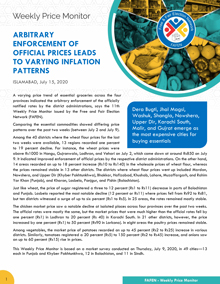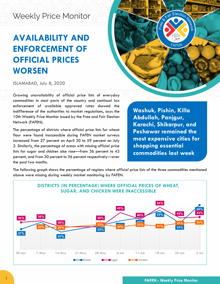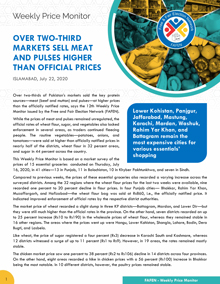- Dera Bugti, Jhal Magsi, Washuk, Shangla, Nowshera, Upper Dir, Karachi South, Malir, and Gujrat emerge as the most expensive cities for buying essentials
ISLAMABAD, July 15, 2020: A varying price trend of essential groceries across the four provinces indicated the arbitrary enforcement of the officially notified rates by the district administrations, says the 11th Weekly Price Monitor issued by the Free and Fair Election Network (FAFEN).
Comparing the essential commodities showed differing price patterns over the past two weeks (between July 2 and July 9).
Among the 40 districts where the wheat flour prices for the last two weeks were available, 13 regions recorded one percent to 19 percent decline. For instance, the wheat prices were above Rs1000 in Hangu, Gujranwala, Lodhran, and Vehari on July 2, which came down at around Rs850 on July 9. It indicated improved enforcement of official prices by the respective district administrations. On the other hand, 14 areas recorded an up to 18 percent increase (Rs10 to Rs140) in the wholesale prices of wheat flour, whereas the prices remained stable in 13 other districts. The districts where wheat flour prices went up included Mardan, Nowshera, and Upper Dir (Khyber Pakhtunkhwa), Bhakkar, Hafizabad, Khushab, Lahore, Muzaffargarh, and Rahim Yar Khan (Punjab), and Kharan, Lasbela, Panjgur, and Pishin (Balochistan).
Just like wheat, the price of sugar registered a three to 12 percent (Rs1 to Rs11) decrease in parts of Balochistan and Punjab. Lasbela reported the most notable decline (12 percent or Rs11) where prices fell from Rs92 to Rs81, but ten districts witnessed a surge of up to six percent (Rs1 to Rs5). In 25 areas, the rates remained mostly stable.
The chicken market price saw a notable decline at isolated places across four provinces over the past two weeks. The official rates were mostly the same, but the market prices that were much higher than the official rates fell by one percent (Rs1) in Lodhran to 20 percent (Rs 40) in Karachi South. In 21 other districts, however, the price increased by one percent (Rs1) to 50 percent (Rs90 in Larkana). In eight areas the poultry prices remained stable.
Among vegetables, the market price of potatoes recorded an up to 45 percent (Rs2 to Rs25) increase in various districts. Similarly, tomatoes registered a 20 percent (Rs5) to 150 percent (Rs2 to Rs45) increase, and onions saw an up to 60 percent (Rs15) rise in prices.
This Weekly Price Monitor is based on a market survey conducted on Thursday, July 9, 2020, in 49 cities—13 each in Punjab and Khyber Pakhtunkhwa, 12 in Balochistan, and 11 in Sindh.
The officially notified price lists of various commodities—mainly wheat, poultry, pulses, and meat—were unavailable in various parts of the country during the reporting week. The official prices of 20-kilogram wheat flour bags were inaccessible in around 55 percent of the surveyed cities. It was most notable in Sindh and Khyber Pakhtunkhwa where 82 percent and 69 percent of the surveyed markets did not publicly display the price lists. Similarly, the wheat prices were missing in around a third of the observed markets in Punjab and Balochistan. The markets had seen a similar trend a week ago.
The official sugar prices were missing in 43 percent districts—92 percent in KP, 33 percent in Balochistan, 27 percent in Sindh, and 15 percent in Punjab. Similarly, the chicken prices were not obtainable in 29 percent districts overall—55 percent in Sindh, 50 percent in Balochistan, and 23 percent each in KP and Punjab.
The official rates of four pulses—moong, masoor, mash, and chana—were not available in six percent to 12 percent of the surveyed markets. The prices of pulses were missing mostly in Balochistan and Sindh. At the same time, milk and yogurt rates were not publicly obtainable in 22 percent and 31 percent districts, respectively.
Moreover, mutton and beef prices were missing in 18 percent and 16 percent of the districts. The official price lists of regular vegetables—potatoes, onions, and tomatoes—were found inaccessible in around 18 percent of the Sindh markets and 19 percent of markets in Balochistan. Punjab and Khyber Pakhtunkhwa did well in making available the official prices of vegetables.
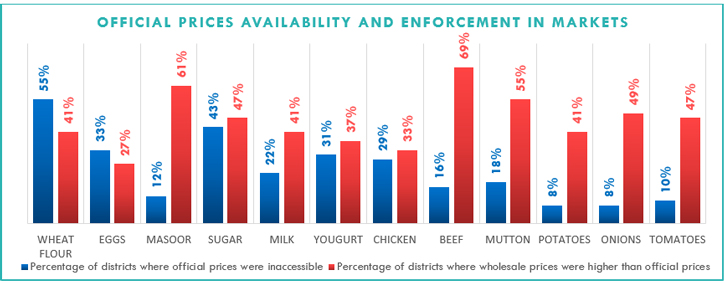
The lax enforcement of official prices burdened the ordinary citizens as traders sold several commodities at higher rates than the officially notified prices.
Among the routine commodities, the implementation of official prices was the weakest when it came to pulses and meat. Daal masoor was overpriced in 61 percent of the surveyed districts, moong (57 percent), chana (49 percent), and mash (59 percent) of the areas. These four pulses went Rs108 to Rs163 above the official price. Karachi South remained the most expensive city to shop for most pulses for the third consecutive week. During the reporting week, Nowshera also emerged on the list of costly cities for pulses with the highest price of daal moong. Khyber Pakhtunkhwa and Sindh were most notable in weak enforcement of pulses’ official rates, as shown in the corresponding graph.
Among the everyday vegetables, onions, tomatoes, and potatoes were overpriced in 49 percent, 47 percent, and 41 percent districts, respectively. The price of tomatoes went Rs56 higher than the notified rate in Dera Bugti, while the potatoes and onions were sold Rs30 and Rs28 above the announced prices in Gujrat and Upper Dir.
In the meat category, beef and mutton (average quality with bone) were overpriced in 69 percent and 55 percent of the surveyed districts, and chicken in 33 percent of areas. Mutton, beef, and chicken were priced at Rs929, Rs449, and Rs132, respectively, above the official rates. Karachi remained the most expensive market for mutton, beef, and chicken last Thursday, as was the case the week before. Traders sold wheat flour and refined sugar above the official rates in 41 percent and 47 percent districts. A 20-kilogram bag of wheat flour was priced Rs300 above the official rate in Washuk, and refined sugar Rs21 more than the market price in Karachi South.
The market rates of eggs per dozen were above the officially notified prices in 27 percent districts. At the same time, the prices of milk and yogurt were higher than the official rates in 41 percent and 37 percent of the surveyed areas.
TDEA-FAFEN generates the Weekly Price Monitor covering 15 essential kitchen items, including groceries such as wheat, pulses, oil, sugar, and perishable commodities like meat, and vegetables. It does this considering the need for an independent and regular assessment of the availability of such items.
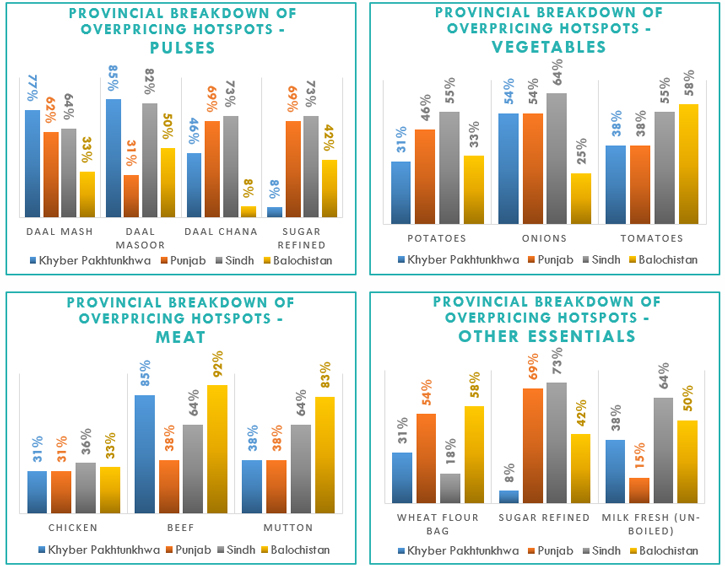
The observers obtain the official prices from the officials of district administrations, or market committees, and collect the wholesale prices through market surveys. In Punjab’s case, the government price app Qeemat Punjab is also used to get the official rates.
To download the report, click here

